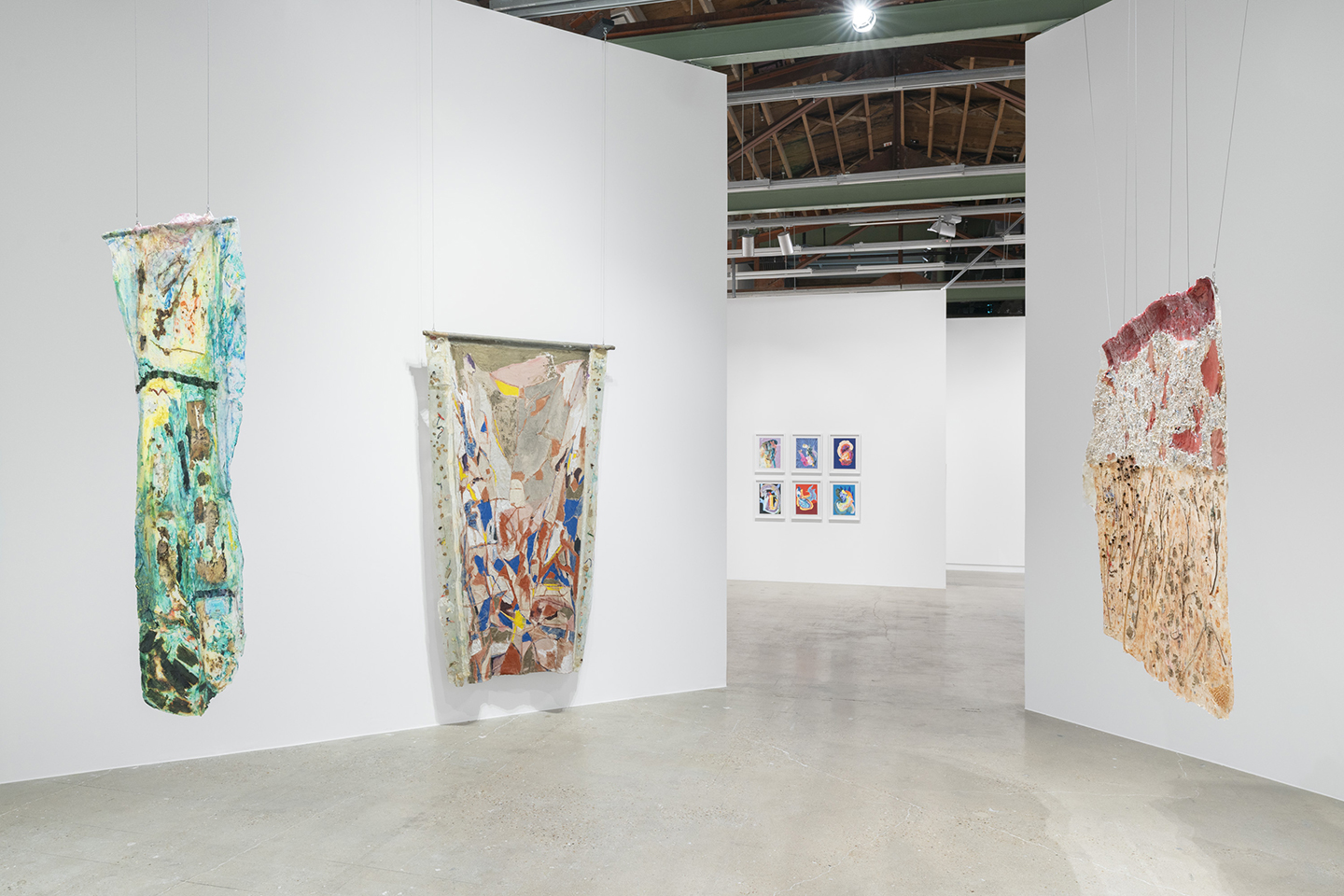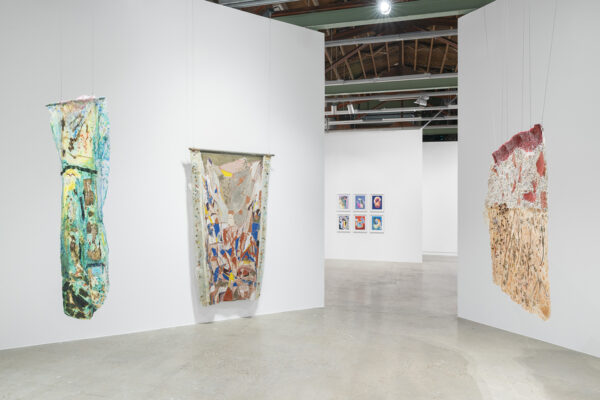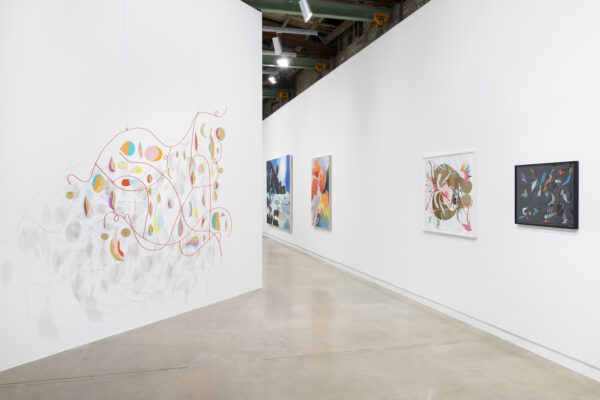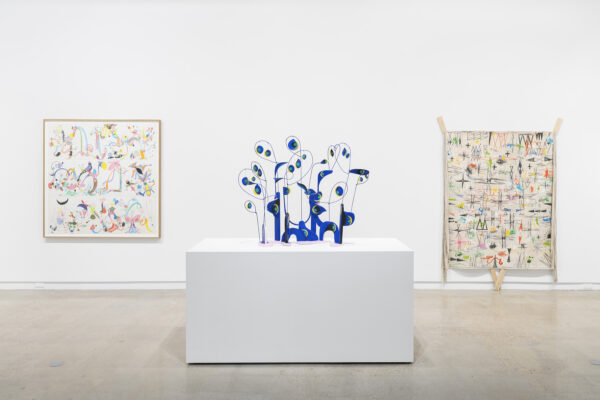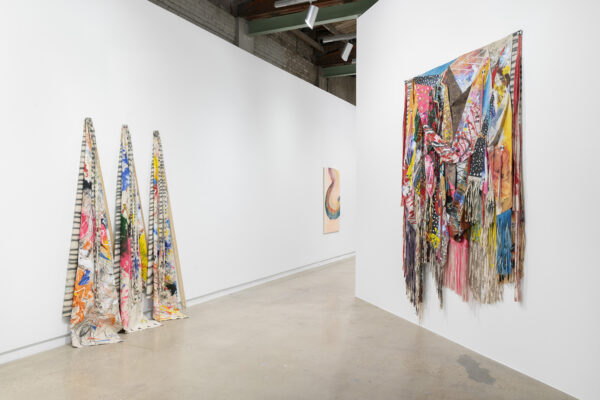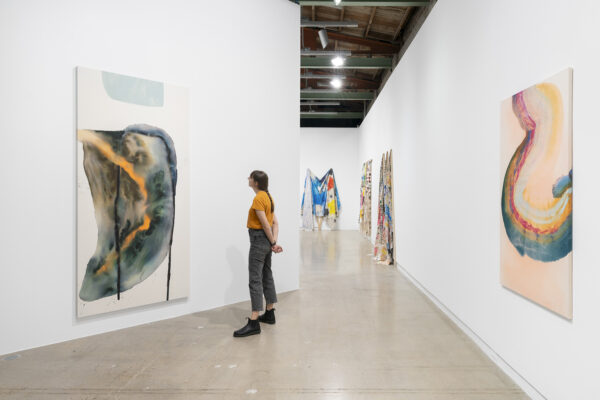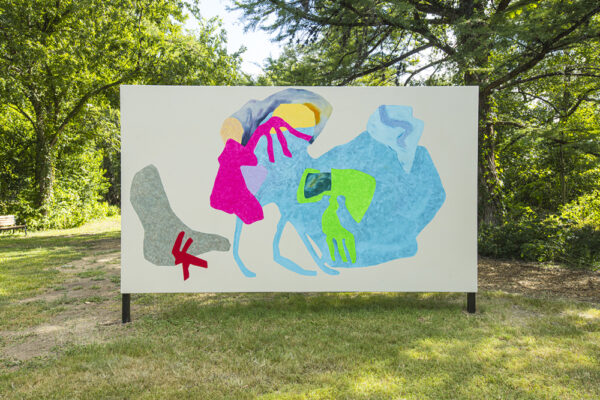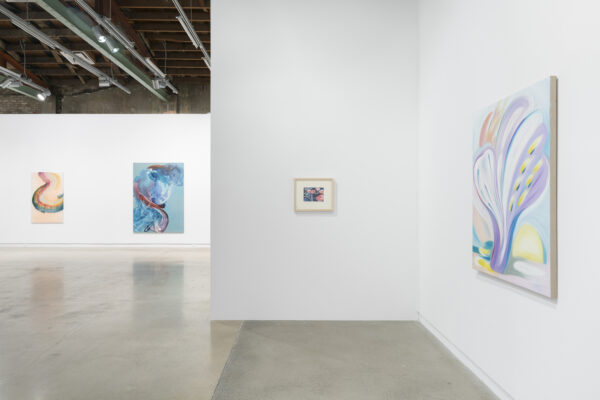Have you ever felt an uncanny nostalgia for the future? You are in luck. A sense of longing, familiarity, and impassionment is omnipresent in The Contemporary Austin’s new group show of abstract painting, The Canvas Can Do Miracles. Despite the title’s implications, this is more than a show about abstract painting, as it includes sculpture and some experimental interventions that change our perception of a traditional approach to the canvas. Works by five intriguing artists are surprisingly cohesive here, despite widely disparate conventions and intentions, exhibiting a healthy demonstration of the power of inter-engaging our differences. Suzanne Jackson, Nathan Carter, Patrick Dean Hubbell, Ragna Bley, and Hayal Pozanti lead us with safe passage through an explosion of hues under the refined curatorial eye of Alex Klein with assistance from Rachel Eboh.
I am greeted by a powder blue wall displaying the show title in a whimsical retro font; it’s a lyric from the Christopher Cross song “Sailing,” a dreamy yacht rock classic that contemplates fantasy, escape and persuasion. Cross is right, we can be transformed by art, and this exhibition is no exception. Hailing from various corners of the globe, the paintings and sculptures on the second floor of The Contemporary are deep in an exchange of pictorial linguistics, glowing and refracted within the ingenious layout. Suzanne Jackson’s rainbow shrouds hang in the center of the room, protected by four walls that create a mother nucleus. The others circle her legacy, cordoned off into their own quadrants, like a wrestling match with doubles and Jackson as the referee. Under typical circumstances, such a geometric taxonomy would be avoided, but here Klein displays her smooth talents with these holy compartments, chapels of color and incubators of power, all. Undoubtedly, we are witnessing a five-pointed amoebic supergroup.
An installation view of works by Suzanne Jackson in “The Canvas Can Do Miracles,” at The Contemporary Austin – Jones Center on Congress Avenue, Austin, Texas, 2025. Image courtesy of The Contemporary Austin. Photo: Alex Boeschenstein
The celebrated artist Suzanne Jackson dazzles at the helm with her four suspended works challenging any traditional notion of what constitutes a painting. These are her “environmental abstractions” with substrate mosaics of acrylic gesture, found materials, natural elements, and textiles, cemented together to give new life to the discarded. Her history as an activist, poet, educator, and theatrical costume designer converges here, exploding with defiant landscapes — encapsulated bits of industrial psychedelia that transform with time spent looking. Jackson is like the sourdough starter of the show, giving birth to younger generations but one step ahead of her own game. Her work shows absolutely no fear and uses everything, so nothing will go to waste. The two pieces that hang independently away from the wall contain fortitude, giving us a private view of their reverse, the blueprint underneath that reveals small traces of making. These are royal garments, capes for future heroes, lingering to be earned, as they lie in wait to receive us inside this sanctuary cell.
An installation view of works by Nathan Carter in “The Canvas Can Do Miracles,” at The Contemporary Austin – Jones Center on Congress Avenue, Austin, Texas, 2025. Image courtesy of The Contemporary Austin. Photo: Alex Boeschenstein
Outside of the cell walls, we walk toward the west and turn left to behold the marvelous universe of Nathan Carter. This Brooklyn-based artist shines in the shadows, holding his coded paths aloft. His drawings, sculpture, mobiles, and paintings possess an instantaneously recognizable style. Playful yet deep and abstract while symbolic, his cosmology lures the viewer into a world of unapologetic freedom, experimental insolence, and unlimited flow. He is clearly friends with his “inner yes.” Made specifically for the exhibition, Carter’s extraordinary new wall mobile of pastels and bronze became a magic portal during his artist talk, when his queer, punk alter ego Mars performed collaboratively with the sculpture. He massaged its pathways with his iPhone, blasting the band Fugazi, and “played” the metal with his cordless mic, creating a room-silencing moment of complete awe.
An installation view of works by Nathan Carter in “The Canvas Can Do Miracles,” at The Contemporary Austin – Jones Center on Congress Avenue, Austin, Texas, 2025. Image courtesy of The Contemporary Austin. Photo: Alex Boeschenstein
On the opposite wall, Carter’s cut paper collage, Wilamena Wild Pansy Threatening, appears like a sexual explosion of flora. The long lucid titles of his works are flaneurs — it doesn’t matter where they go or when they land, you are along for the ride. Case in point: the large drawing Metamorphic phase intersexual botanical beings curious proliferations deadly fang panorama stamen ovule tentatively intertwining and coupling in a self-stimulating dance looks like an ancient scroll, with multiple pages connected on the left and right margins, but not on the top or bottom. Carter seems to have engaged in an exquisite corpse drawing game with himself, an exercise in restraint and imagination. I can’t stop seeing yonis, lips, legs, sperm, eels, fingernails, teeth, cacti, sphincters as flowers and vice-versa, pennant banners, palms, eyebrows, and…actually, amoebas.
Another celestial wall mobile (from a lucky private collection!) is relatively minimal, with a motif of moon cycles and the astral plane. I could stare at this formal arrangement for hours, all welded steel and brass shapes, which complement the applied acrylic Yves Klein blue, bursting any sensory calmness. The Calderesque tabletop sculpture lives in a similar realm of whimsical shape, but I do miss the beckoning shadows created by the mobiles hung in front of the walls. Still, it is clearly a showstopper with a bossy side, demanding to be seen from multiple angles of the room and through the back doorway of the center cell. Carter is maddeningly cohesive and singular in every medium he selects. Maybe this mastery comes from living your truth: the essence of punk mayhem, the homemade spikes on your pumps, the self-assurance that knows that if you lost all your worldly possessions, you would still have a kingdom of majesty within your living essence.
An installation view of works by Patrick Dean Hubbell in “The Canvas Can Do Miracles,” at The Contemporary Austin – Jones Center on Congress Avenue, Austin, Texas, 2025. Image courtesy of The Contemporary Austin. Photo: Alex Boeschenstein
His scroll drawing morphs seamlessly into the first of five contemporary paintings by Patrick Dean Hubbell, where his deconstructed canvases celebrate patterning, defacement, and the history embedded in his ancestral Diné culture. Each New Day Brings Challenges, Your Words Fortify Our Spirit, made from oils, acrylics, enamel, charcoal, sewing and wood, continues this exhibition’s zeitgeist of both prolix titles and the expansive layering of materials. The drawings evoke tramp markings, a new pattern language with stars, rugs, tepee shapes, and hourglasses that present a cuneiformed blueprint for future eyes. When I take in the expanse of Hubbell’s work, I am overcome with the emotion contained in these objects: Think flags, shawls, celebrations, triads, craft, community, warnings, and anger.
I feel confronted by these works, almost as if they are shouting at me, trying to awaken a dormant set of knowledge. But I can’t look away. This does not drive me from them but only entices me further with their chaos motifs and intense resilience. My peripheral vision of these five works references drying meats, blankets, herbs, Jasper Johns, and, above all, mark-making intended to last. Layered and bundled fabrics in Your Perseverance Taught Us to Rise to Each New Day inspire anthropomorphism. Figurative forms emerge from the jumble and I sense that I am in conversation with three elders who traverse time, brandishing their ancient markings with neon accents. Key to note here that all of Hubbell’s works are from the last year or two, cementing his vision within a prolific practice. The pieces photograph beautifully, with the frenetic combinations instantly converging into iconic images. The draping of these reimagined canvases is also anchored in traditionally female work, showing that Hubbell can consider all sides of his ancestry and influences, while summoning stunningly original contemporary paintings with fortified sincerity.
An installation view of works by Ragna Bley in “The Canvas Can Do Miracles,” at The Contemporary Austin – Jones Center on Congress Avenue, Austin, Texas, 2025. Image courtesy of The Contemporary Austin. Photo: Alex Boeschenstein
Down the north wall, the quieter work of the Swedish-born painter Ragna Bley reveals itself. This young artist has ten works on display: three larger canvases, a grid of six smaller studies, and a site-specific installation on the extended Laguna Gloria grounds. Bley engages the fickle elements of the natural world as a co-conspirator for her outdoor piece in the sculpture garden, a double-sided work with two paintings. Solaris was made with temperature sensitive pigment while Mammoth, on the reverse, holds pockets of dyes and elements that will eventually melt away and advance the piece. I appreciate Bley’s embrace of risk and absolute sacrifice, as most artists rely on control with their work, and here, she is trusting the friction of weather.
Ragna Bley, “Solaris,” 2025, thermochromic paint, acrylic paint, gesso, primed cotton canvas, and steel, 96 1/8 x 165 3/8 x 2 inches. An installation view of “The Canvas Can Do Miracles,” at The Contemporary Austin – Laguna Gloria, Austin, Texas, 2025. Artwork © Ragna Bley. Commissioned by The Contemporary Austin, courtesy of the artist. Photo: Brian Fitzsimmons, courtesy of The Contemporary Austin
This spirit is less evident in Bley’s paintings, which she executes in her Oslo studio. She practices with a physicality that pushes paint onto the floor-based canvases with wild gesture and organic movement that comes through in the final works. Antarctica possesses an energy of the sea, with a quality that evokes both batik dyes as well as the squeegee technique of Jack Whitten and Gerhard Richter. But amid this grouping, Inter-waver is the most successful, a dark embryo of colors and energetic veins that balances delicately with the raw texture of the negative spaces of the canvas. Like her ambitious experiment at the museum’s Laguna Gloria campus, Bley will ripen with time and likely bloom into unexpected brilliance.
An installation view of works by Ragna Bley and Hayal Pozanti in “The Canvas Can Do Miracles,” at The Contemporary Austin – Jones Center on Congress Avenue, Austin, Texas, 2025. Image courtesy of The Contemporary Austin. Photo: Alex Boeschenstein
In the final corner of the show, the five paintings and one sculpture of the Turkish artist Hayal Pozanti round out this superb presentation of contemporary painting. Working in Manchester, Vermont, she uses motion, levity, and the natural world to concoct a universe of encrypted meanings within her abstracted landscapes. Created in oil pastels and sticks, her canvases ooze with primordial bulbosity, showcasing fuzzy focused forms that delight and undulate under her hand. Both The Slumbering Seed Within My Heart and This Sudden Smiling seem to reveal a spirit in love, forces of eternal motion and no time for stillness. Sublime joy can be hard to recognize but you can witness it here, guilt free and without compromise.
The larger paintings sing with power, what I would deem museum-ready, and not because they recall the early sensuality of Georgia O’Keefe. The over-scaled presence of these is where Pozanti thrives best. The largest canvas, Veil Between Worlds, commands the corner with charm and fluidity, a perfect study in unexpected color. This is nature’s quilt in the absence of people — full of liquid, wind, and possibility. Another work of the same size, A Glimmer To Build Your World On, needs more room to breathe. I cannot stand back far enough to let the abstractions congeal, and the blurred strokes of oil stick exhaust my stationed tenure in the space. In the center of the paintings, Pozanti experiments with a version of her vision. A Pillow of Winds, a printed Dibond and steel sculpture, adds a fresh dimension to her practice, although real paint would have been preferred over the UV printing. Here, the fluid suspension of fantasy that makes her work so enjoyable is mitigated by the medium of computerized replication. Mirrored cut-outs insert the viewer into this landscape, now open to the presence of humans, at least the one that is sharing space with this shapely object. We hold our own gaze, divining various worlds of biological constructs.
And what does the future hold? Maybe I am wishing for a technicolor future that looks like this stellar exhibition, one that celebrates differences and cherishes the visionary. One that inspires us to hold each other close and that makes all our fires brighter, illuminating the darkness that we need for making the light.
The Contemporary is asking all the right questions and giving us ample platforms to wonder, to share, to look, to debate, to converse with The Canvas Can Do Miracles as well as the excellent accompanying exhibitions Teddy Sandoval and the Butch Gardens School of Art and HOST: Raul De Lara. Go. See. Art. Y’all. We need more miracles in our lives.
The Canvas Can Do Miracles is on view at The Contemporary Austin through January 11, 2026.

